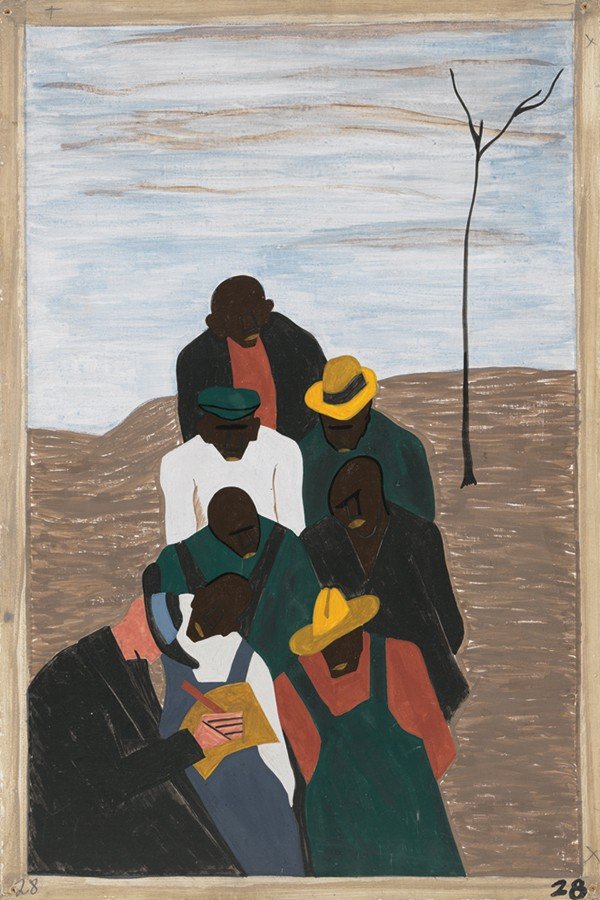Jacob Lawrence:
The Great Migration
3 From every southern town migrants left by the hundreds to travel north.
If you‘ve ever looked up and seen a flock of small starlings swooping and soaring in exuberant flight, you’d know that migration is always a miraculous sight. Suddenly, for no reason, they just pick up and fly. And even more amazing is the fact that they are truly hardwired. In late summer the American Golden-Plover begins a flight of over 10,000 miles from their breeding grounds in Northern Canada to the grasslands of South America, including a nonstop flight of up to 3500 miles over the open Atlantic Ocean, and then in late Spring flies back to the tundra again.. It’s something to see. But it’s a story of survival, just like any other life.
Likewise, it’s the story of the Great Northern Migration, which took place in the United States between 1915 - 1960, when six million African American left their homes in the rural South for new jobs in the industrial North. Six million people boarded trains or even walked hundreds of miles to get away from the poverty and punishments of the post-Civil War South that kept ex- slaves in servitude when, in fact, they were free. Even though they had been“freed” by the passage of the Thirteenth Amendment (in 1865,) they weren’t “free” by any means. They couldn’t go to White schools; they couldn’t sleep in White hotels; they couldn’t sit on buses, etc. Even as late as 1963, George Wallace was overwhelmingly elected Governor of Alabama by declaring, “And I say segregation now, segregation tomorrow, and segregation forever!”
It was not an easy journey, but it was past time to leave. The factory workers of the Northern industrial cities like Detroit, Chicago, Pittsburgh, and Philadelphia were being drafted by the government to fight World War I (1917 - 1919) and so the factory owners began looking to the South for new workers to replace them. The owners, in fact, even paid for the trains which brought the rural Southerners to the cities in the North.
13 The crops were left to dry and rot. There was no one to tend them.
15 There were lynchings.
One of the migrant families moving North was Jacob Lawrence’s family. They made it as far as New Jersey where he was born in 1917. And where he and his three brothers lived until their parents separated and placed them all in foster care. Eventually, when he was thirteen, his mother took her four sons north to Harlem, New York, the site of the “Harlem Renaissance,” Between the end of World War I (1917) until the beginning of World War II, the Harlem Renaissance was an African American hotbed of dazzling artistic and cultural activity. The legendary artists who emerged from this period, including Langston Hughes, Ralph Ellison, Zora Neale Hurston, Richard Wright and Duke Ellington. And Lawrence emerged from this artistic hotbed too since it was at the Harlem Art Workshop in 1932, where he studied under Charles Alston, that he began to develop his unique style of abstract figures and flat primary colors. At twenty one, he had his first solo exhibition at the Harlem YMCA and in 1940, while still only twenty three years old, he created a sixty-panel piece then entitled “The Migration of the Negro” and now known as “The Migration Series” which rocketed him to fame. The now legendary 60-panel series is now split between the Phillips Collection in Washington D.C., and the Museum of Modern Art (MoMA) in New York City. Lawrence then became the first African American artist represented in MoMA’s collection.
28 The labor agent sent south by northern industry was a familiar presence in the black communities.
39 Railroad platforms were piled high with luggage.
The brilliance of the series is that it represents both the hope and despair of the migratory journey. The ride North was initially easy, but they soon realized that the jobs were not as high- paying as the factory owners had promised. And also, since their expertise was in agricultural work, they were only given unskilled positions (and pay) in heavy industry. They’d made the migration with good intent, but as August Wilson said, “it was a transplant that didn’t take.” However, either way, there was a flight that was something to see, and Jacob Lawrence told the story of the miraculous sight.
45 The migrants arrived in Pittsburgh, one of the great industrial centers of the North.
58 In the North the African American had more educational opportunities.







